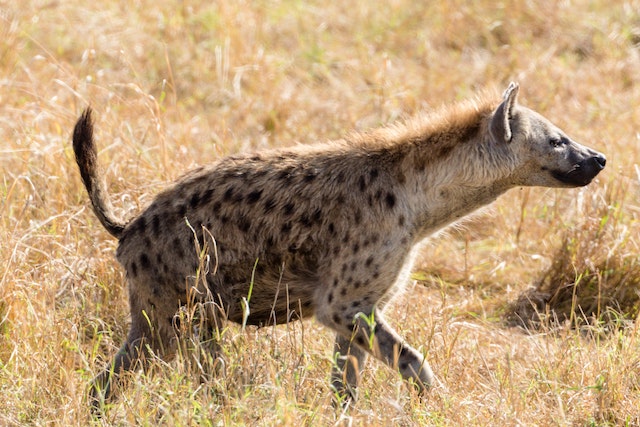
Why do hyenas have long necks? To give them more strength and leverage for when they eat their food.
There are four types of hyena. These are the brown hyena, the aardwolf, the spotted hyena, and the striped hyena. The hyena we most closely associate as a hyena is the spotted hyena. They all vary in different ways, but they have a lot of similarities as well. Hyenas are not actually related to dogs. They travel in packs, catch their prey with their teeth not their claws, and they have non retractable claws, similar to dogs, but they are closer to felines than canines. However, they have their own family, the Hyaenidae, which only has the four different subspecies.
So, why are hyenas the shape that they are? As with every animal, it all comes down to evolution. Every part of their body is the shape that it is because it makes them successful in hunting, finding food, and passing on their genes. Hyenas are known as scavengers, but spotted hyenas are actually more likely to hunt their own prey than they are to scavenge. They work as a pack and can take down many of the same animals that lions will target. In fact, lions and hyenas often hunt the same prey, putting them in direct competition. Many people think that hyenas steal the prey from lions, but research has shown that lions are more likely to steal the prey of a hyena pack. When lions hear the cries of hyenas eating, they head for the pack. The hyenas won’t take on the lions and stand apart until the lions have finished eating. This may be where the image of them as scavengers comes from. That being said, they will scavenge and are notorious for eating anything.
The first adaptation that hyenas have is their rump. Many large cats have a large and extended rump because they need a lot of muscle to be able to jump and to pounce. Hyenas don’t need to do this, so they have a much more rounded rump. This shape makes it a lot more difficult for other animals, such as lions, to get a grip on them.
Another adaptation is their large chest and sloping back. This shape helps them expend less energy when they run. They also have a heart that is 1% of their body weight and very large in comparison to other carnivores. This gives them a lot more stamina and is an adaptation for their hunting style. They usually go through a herd of animals, select one, and then chase it for several kilometers at speeds of up to 60 km/h. They kill the animal when it can’t run any more. Similar to the way humans used to hunt.
Then their long neck. They have very strong neck and shoulder muscles and a long neck, which gives them a lot of leverage. When they have brought down their prey, it is common for other animals to come and steal it, so they want to eat as fast as they can. Their strong neck and shoulders allow them to shake and rip the carcass to pieces extremely quickly. They can also carry it to a safer place. They eat as quickly as they can before their food is stolen.
Next, the size and shape of their head. They have very large heads for their body size, which makes them look uneven. This is because they eat every part of their prey and need jaws that can bite through bone. They have extremely large jaws and jaw muscles to do this. They have a bite force of over 1,000 newtons, which is staggering. One animal tested had a bite force of 4,500 newtons. That makes their bite force stronger than most other animals. They use this to chew up bone.
Finally, hyenas have another adaptation that is inside them. They are able to digest the bones as well as chew them up. Their digestive system is very powerful and can absorb the calcium phosphate in the bones. Some of this also goes through them, which is why hyena poo is actually white. A lot of other animals look for hyena poo to get the calcium phosphate. They also have a lot more bacteria in their guts than we do, allowing them to eat food that would probably kill us.
So, why do hyenas have long necks? To support their incredibly strong jaws and to allow them to rip prey apart quickly. They are perfectly designed for what they do. And this is what I learned today.
Photo by Antony Trivet: https://www.pexels.com/photo/spotted-hyena-walking-on-grassy-terrain-in-savanna-6056066/
Sources
https://www.wyzant.com/resources/answers/642798/explanation-for-hyenas-asymmetric-legs-length
https://biology.stackexchange.com/questions/57458/explanation-for-hyenas-asymmetric-legs-length
https://en.wikipedia.org/wiki/Hyena
https://en.wikipedia.org/wiki/Spotted_hyena
https://animals.sandiegozoo.org/animals/striped-hyena
https://a-z-animals.com/blog/9-strongest-animal-bite-forces-in-the-world/
